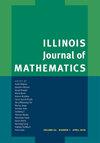Heintze群的度量等价性及其在低维分类中的应用
IF 0.7
Q3 MATHEMATICS
引用次数: 1
摘要
我们通过考虑低维情形和拟等距的同时考虑等距,来处理李群上的拟等距分类问题。首先,我们给出了一些关于Heintze群间拟等距的新结果。然后,我们将看到这些结果以及与等距相关的现有工具如何特别应用于维度4和5的组。因此,我们采取步骤来确定群的所有等价类,直到等距和拟等距。我们完全解决了维数为4的单连通可解群和维数为5的多项式增长群的子类的等距分类。本文章由计算机程序翻译,如有差异,请以英文原文为准。
Metric equivalences of Heintze groups and applications to classifications in low dimension
We approach the quasi-isometric classification questions on Lie groups by considering low dimensional cases and isometries alongside quasi-isometries. First, we present some new results related to quasi-isometries between Heintze groups. Then we will see how these results together with the existing tools related to isometries can be applied to groups of dimension 4 and 5 in particular. Thus we take steps towards determining all the equivalence classes of groups up to isometry and quasi-isometry. We completely solve the classification up to isometry for simply connected solvable groups in dimension 4, and for the subclass of groups of polynomial growth in dimension 5.
求助全文
通过发布文献求助,成功后即可免费获取论文全文。
去求助
来源期刊
CiteScore
0.90
自引率
0.00%
发文量
18
期刊介绍:
IJM strives to publish high quality research papers in all areas of mainstream mathematics that are of interest to a substantial number of its readers.
IJM is published by Duke University Press on behalf of the Department of Mathematics at the University of Illinois at Urbana-Champaign.

 求助内容:
求助内容: 应助结果提醒方式:
应助结果提醒方式:


